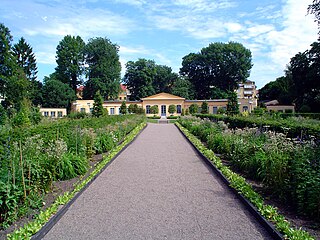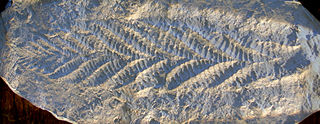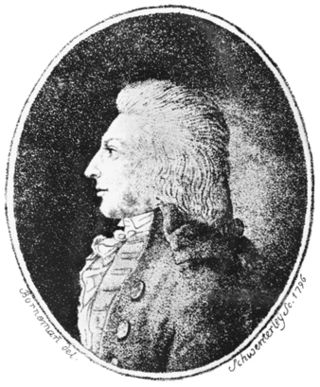
Genus is a taxonomic rank above species and below family as used in the biological classification of living and fossil organisms as well as viruses. In binomial nomenclature, the genus name forms the first part of the binomial species name for each species within the genus.

Order is one of the eight major hierarchical taxonomic ranks in Linnaean taxonomy. It is classified between family and class. In biological classification, the order is a taxonomic rank used in the classification of organisms and recognized by the nomenclature codes. An immediately higher rank, superorder, is sometimes added directly above order, with suborder directly beneath order. An order can also be defined as a group of related families.

The International Code of Nomenclature for algae, fungi, and plants is the set of rules and recommendations dealing with the formal botanical names that are given to plants, fungi and a few other groups of organisms, all those "traditionally treated as algae, fungi, or plants". It was formerly called the International Code of Botanical Nomenclature (ICBN); the name was changed at the International Botanical Congress in Melbourne in July 2011 as part of the Melbourne Code which replaced the Vienna Code of 2005.

A botanical name is a formal scientific name conforming to the International Code of Nomenclature for algae, fungi, and plants (ICN) and, if it concerns a plant cultigen, the additional cultivar or Group epithets must conform to the International Code of Nomenclature for Cultivated Plants (ICNCP). The code of nomenclature covers "all organisms traditionally treated as algae, fungi, or plants, whether fossil or non-fossil, including blue-green algae (Cyanobacteria), chytrids, oomycetes, slime moulds and photosynthetic protists with their taxonomically related non-photosynthetic groups ."

In taxonomy, a nomen nudum is a designation which looks exactly like a scientific name of an organism, and may have originally been intended to be one, but it has not been published with an adequate description. This makes it a "bare" or "naked" name, which cannot be accepted as it stands. A largely equivalent but much less frequently used term is nomen tantum. Sometimes, "nomina nuda" is erroneously considered a synonym for the term "unavailable names". However, not all unavailable names are nomina nuda.

In biological nomenclature, a syntype is any one of two or more biological types that is listed in a description of a taxon where no holotype was designated. Precise definitions of this and related terms for types have been established as part of the International Code of Zoological Nomenclature and the International Code of Nomenclature for algae, fungi, and plants.
The International Association for Plant Taxonomy (IAPT) is an organization established to promote an understanding of plant biodiversity, facilitate international communication of research between botanists, and oversee matters of uniformity and stability in plant names. The IAPT was founded on July 18, 1950, at the Seventh International Botanical Congress in Stockholm, Sweden. The IAPT headquarters is located in Bratislava, Slovakia. Its president, since 2023, is Lúcia G. Lohmann of the Universidade de São Paulo; vice-president is Fabián Michelangeli of the New York Botanical Garden; and secretary-general is Mauricio Bonifacino of the Universidad de la República, Montevideo, Uruguay.
Botanical nomenclature is the formal, scientific naming of plants. It is related to, but distinct from taxonomy. Plant taxonomy is concerned with grouping and classifying plants; botanical nomenclature then provides names for the results of this process. The starting point for modern botanical nomenclature is Linnaeus' Species Plantarum of 1753. Botanical nomenclature is governed by the International Code of Nomenclature for algae, fungi, and plants (ICN), which replaces the International Code of Botanical Nomenclature (ICBN). Fossil plants are also covered by the code of nomenclature.
Nomenclature codes or codes of nomenclature are the various rulebooks that govern the naming of living organisms. Standardizing the scientific names of biological organisms allows researchers to discuss findings.
In botany, the correct name according to the International Code of Nomenclature for algae, fungi, and plants (ICN) is the one and only botanical name that is to be used for a particular taxon, when that taxon has a particular circumscription, position and rank. Determining whether a name is correct is a complex procedure. The name must be validly published, a process which is defined in no less than 16 Articles of the ICN. It must also be "legitimate", which imposes some further requirements. If there are two or more legitimate names for the same taxon, then the correct name is the one which has priority, i.e. it was published earliest, although names may be conserved if they have been very widely used. Validly published names other than the correct name are called synonyms. Since taxonomists may disagree as to the circumscription, position or rank of a taxon, there can be more than one correct name for a particular plant. These may also be called synonyms.
In botanical nomenclature, a hybrid may be given a hybrid name, which is a special kind of botanical name, but there is no requirement that a hybrid name should be created for plants that are believed to be of hybrid origin. The International Code of Nomenclature for algae, fungi, and plants (ICNafp) provides the following options in dealing with a hybrid:
In zoological nomenclature, the valid name of a taxon is the correct scientific name for that taxon. The valid name must be used for that taxon, regardless of any other name that may currently be used for that taxon, or may previously have been used. A name can only be valid when it is an available name under the International Code of Zoological Nomenclature (ICZN); if a name is unavailable, then it cannot be considered either valid or invalid.

A conserved name or nomen conservandum is a scientific name that has specific nomenclatural protection. That is, the name is retained, even though it violates one or more rules which would otherwise prevent it from being legitimate. Nomen conservandum is a Latin term, meaning "a name to be conserved". The terms are often used interchangeably, such as by the International Code of Nomenclature for Algae, Fungi, and Plants (ICN), while the International Code of Zoological Nomenclature favours the term "conserved name".

Form classification is the classification of organisms based on their morphology, which does not necessarily reflect their biological relationships. Form classification, generally restricted to palaeontology, reflects uncertainty; the goal of science is to move "form taxa" to biological taxa whose affinity is known.

In biology, taxonomic rank is the relative or absolute level of a group of organisms in a hierarchy that reflects evolutionary relationships. Thus, the most inclusive clades have the highest ranks, whereas the least inclusive ones have the lowest ranks. Ranks can be either relative and be denoted by an indented taxonomy in which the level of indentation reflects the rank, or absolute, in which various terms, such as species, genus, family, order, class, phylum, kingdom, and domain designate rank. This page emphasizes absolute ranks and the rank-based codes require them. However, absolute ranks are not required in all nomenclatural systems for taxonomists; for instance, the PhyloCode, the code of phylogenetic nomenclature, does not require absolute ranks.

In mycology, a sanctioned name is a name that was adopted in certain works of Christiaan Hendrik Persoon or Elias Magnus Fries, which are considered major points in fungal taxonomy.
In botanical nomenclature, a validly published name is a name that meets the requirements in the International Code of Nomenclature for algae, fungi, and plants (ICN) for valid publication. Valid publication of a name represents the minimum requirements for a botanical name to exist: terms that appear to be names but have not been validly published are referred to in the ICN as "designations".
Authors of Plant Names by Richard Kenneth Brummitt and C. Emma Powell, 1992, is a print database of accepted standardized abbreviations used for citing the author who validly published the name of a taxon. The database is now maintained online at the International Plant Names Index. The book provides recommended abbreviations for authors' names that help to distinguish authors with the same surname when giving the full name of a taxon. It deals authors who validly published the name of a flowering plant, gymnosperm, fern, bryophyte, algae, fungi or fossil plants. Prior to its publication in 1992, many abbreviations for authors to be cited could be found in Taxonomic literature. A selective guide to botanical publications and collections with dates, commentaries and types. by F. A. Stafleu & R. F. Cowen, 1976–1988.
The Kew Rule was used by some authors to determine the application of synonymous names in botanical nomenclature up to about 1906, but was and still is contrary to codes of botanical nomenclature including the International Code of Nomenclature for algae, fungi, and plants. Index Kewensis, a publication that aimed to list all botanical names for seed plants at the ranks of species and genus, used the Kew Rule until its Supplement IV was published in 1913.
Capelio is a genus of flowering plant in the Asteraceae first described as a genus in 1836 with the name Alciope. It was renamed Capelio in 2002 after it was determined that the name Alciope was not legitimately published according to international nomenclatural rules. Capelio is a taxonomic anagram derived from the former name Alciope.










